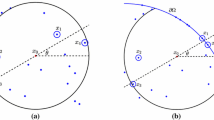Abstract
The FDEM program package is a black-box solver for nonlinear systems of elliptic and parabolic PDEs. A FDM of arbitrary consistency order q on an unstructured basic FEM mesh is used. With the difference formula of order q+2 an error estimate is computed. A sophisticated algorithm has been developed to generate reliable difference formulae of order q on an unstructured grid. Completely new is the usage of the error estimate to determine under such general conditions for each node i its individual optimal order q(i) out of the orders 2, 4, 6. This order control tells us that higher order may be better or may not be better, depending on the character of the solution and the used mesh.
Similar content being viewed by others
REFERENCES
Adolph, T., and Schönauer, W. (2001). The concept of dividing lines/surfaces for the finite difference element method (FDEM). To appear in Proc. GAMM-Tagung, Zürich.
Adolph, T., and Schönauer, W. (2001). The generation of high quality difference and error formulae of arbitrary order on 3-D unstructured grids. ZAMM 81, Supplement 3, pp. 753–754.
Gutknecht, M. H. (1993). Variants of BICGSTAB for matrix with complex spectrum. SIAM J. Sci. Stat. Comput. 14, 1020–1033.
Häfner, H., Schönauer,W., and Weiss, R. (1999). Parallelization and integration of the LU and ILU algorithm in the LINSOL program package. In Malyshkin, V. (ed.), Parallel Computing Technologies, Springer Lecture Notes in Computer Sciencen, Vol. 1662, Berlin, pp. 417–427.
Häfner, H., Schönauer, W., and Weiss, R. (1998). The parallel and portable linear solver package LINSOL. In Lederer, H., and Hertweck, F. (eds.), Proceedings of the Fourth European SGI/Cray MPP Workshop, IPP R/46, Max-Planck-Institut für Plasmaphysik, Garching bei München.
Häfner, H., Schönauer, W., and Weiss, R. (1999). The program package LINSOL: Basic concepts and realization. Appl. Numer. Math. 30(2–3), 213–224.
Schönauer, W., and Adolph, T. (2001). Accurate parallelized solution for coupled domains: The FDEM (Finite Difference Element Method) with dividing lines/surfaces. In de Vahl Davis, G., and Leonardi, E. (eds.), CHT'Ø1, Advances in Computational Heat Transfer, Vol. 1, Begell House Inc., New York, pp. 445–452.
Schönauer, W., and Adolph, T. (2000). Development of a black-box solver for nonlinear systems of elliptic and parabolic PDEs. In Neittanmäki, P., Tiihonen, T., and Tarvainen, P. (eds.), Proc. 3rd European Conf. Numerical Mathematics and Advanced Applications, World Scientific Publishing, Singapore, pp. 698–706.
Schönauer, W., and Adolph, T. (2001). How we solve PDEs. J. Comput. Appl. Math. 131, 473–492.
Schönauer, W., and Adolph, T. (2000). The FDEM (Finite Difference Element Method) program package: Fully parallelized solution of elliptic and parabolic PDEs. Proceedings of ECCOMAS 2000, Barcelona, CD ROM ECCOMAS 2000, Laboratori de Calcul de la Facultat d'Informatica de Barcelona (FIB, UPC), ISBN 84–89925–70–4, Barcelona, 20 pages.
Schönauer, W. (1998). Generation of difference and error formulae of arbitrary consistency order on an unstructured grid. ZAMM 78, Supplement 3, pp. 1061–1062.
Schönauer, W. (2000). Scientific Supercomputing: Architecture and Use of Shared and Distributed Memory Parallel Computers, Self-edition Schönauer, W., Karlsruhe, Germany, ISBN 3–00–005484–7, see also http: //www.uni–karlsruhe.de/ ~rz03/book/.
Author information
Authors and Affiliations
Rights and permissions
About this article
Cite this article
Schönauer, W., Adolph, T. Higher Order May Be Better or May Not Be Better: Investigations with the FDEM (Finite Difference Element Method). Journal of Scientific Computing 17, 221–229 (2002). https://doi.org/10.1023/A:1015108916339
Issue Date:
DOI: https://doi.org/10.1023/A:1015108916339




